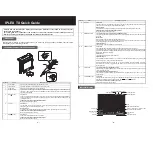
11
Finish
Before starting the finish make sure all holes are drilled for any remaining hardware (pickguard, jack
plate, strap pins etc).
The Body
Sand the body and neck with #220 dry sandpaper, followed by #320. If you are applying a finish, other
than natural, you should consider using a grain filler on the body. This will fill in the valleys in the grain
and result in a nice flat surface allowing you to get a nice high gloss finish. An oil based grain filler is
recommended. For most finishes use a natural colored filler. The dyes used in darker fillers may over
time find their way through the color coat.
Apply the filler by wiping across the grain. You can use a course cloth or your fingers to wipe the grain in.
After it has dried about ten to twenty minutes the excess can be removed with a cloth dampened with
mineral sprits. After about an hour repeat the process and let dry overnight. If you have removed most
of the excess with mineral spirits the remaining filler on the field of the wood can be sanded off (use
#220 again) in a few minutes. It is also a good idea at this time to reopen any of the screw holes in the
body. Use a toothpick or small drill held between your fingers to clean out any filler in the holes. The
body is now ready for a sand and sealer coating.
Sand and sealer is used to give the final coat a level base. It is also helpful in filling scratches which are
too deep to sand out.
Solid Color Finish
The last step before applying the color coats is to apply a white primer coat. B.I.N.s makes a white
pigmented shellac in an aerosol can that will cover the grain and prevent any previous finishes from
bleeding through. The white background will also let you apply an opaque color coat with less paint. You
can find this sealer at most hardware stores. Spray on two coats. When dry you may notice that the
surface feels rough. Sand off the roughness with #320 dry and respray. Sand again. If the surface now
appears smooth and all grain is opaqued you are ready for the color coat.
The Neck
The neck has been finished and should require anyting.
Setup
Fender uses a small wooden wedge (1" wide x 2" long, tapering from 1/4" to 1/2") to "block" the
tremolo block when setting up tremolo guitars. It removes the issue of dealing with the intricate string-
to-spring tension balance. It's probably worth the effort to have a similar block of wood if you are
setting up a tremolo guitar. This means that the springs are not installed until the very last step.































